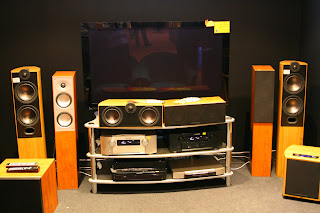The Exhibition runs for 3 days from 24th (Friday) to 26th(Sunday) and the entrance fee is RM 10 per person. The exhibition is held at the 5 star JW Marriott Hotel Kuala Lumpur which is beside two ultra luxurious shopping centre's, Pavilion KL and Starhill Gallery. The crowd was quite huge. Many of them consist of audiophiles and videophiles.
Large Crowd in the Main Exhibition Hall
Ok, I'll start with the basic systems and proceed on to the more advanced reference ones, which are located at the Conference Centre of JW Marriott.
First up, we have home theatre systems on demo by 'Desa Home Theatre Sdn Bhd'. These are relatively basic entry level systems, costing between RM 10000 and RM 30000 (yeah thats entry level in the high end world). Pictures to follow.
Entry level Home Theatre Package
Next, we have some midrange integrated and power amps by Marantz. These units costs about RM 30000 each and are quite good. Some of them have the word KI in their name, which stands for 'Ken Ishiwata' (the lead design engineer for Marantz).
Quoted by Marantz Themselves:
"The KI Signature series is a personalised range produced by Ken Ishiwata that represents the cutting edge of design and engineering expertise. Each component is individually selected and painstakingly crafted to obtain the highest audio quality. In final preparation, each model is rigorously tested for 48 hours to ensure flawless musical reproduction. Every component in the KI Signature series is constructed using anti-vibration solid metal and has a copper-plated chassis to reduce signal-degrading electromagnetic radiation and mechanical vibration. The use of UK-designed toroidal power transformers, with ultra-low vibration and leakage flux, also helps keep signals sharp"
Marantz Amplifiers Marantz SA7-SI SACD player
Next, we have this crazy dude who modifies car audio systems. This guy even managed to fit in a 42 Inch Pioneer KURO Plasma Display into the backseat, by pushing the seats to the trunk compartment area. Absolutely wicked !!! Take a look :
42 Inch KURO Plasma for backseat viewers
The Pioneer Surround Speakers and amplifiers behind the backseat
Moving on to the 7th and 8th floors of JW Marriott, we could sense the aura of high end creeping in. What we have here (in the pic below) is a very unique audio source. Take a look at the white MacBook on the far right. The MacBook acts as a digital audio source, delivering pure audio signals via Firewire 400 to a Weiss DAC (Digital to Analogue Converter). The signal from the DAC is then transferred to the Gryphon Pre-Amplifier and Gryphon Colosseum Power Amplifier which provides the juice for delivering the sound to the loudspeakers.
P/S: Sry my lens wasn't wide enough to capture the entire scene

The Gryphon System
We then proceeded further to the 'Audio Perfectionist Sdn Bhd' showroom. On demo was a McIntosh 1k Reference system. We tested a couple of tracks from the CD and was ultimately dumbfounded by the ultra high realism and dynamics of the sound. It sounded very "alive". Mind you, the speakers in the picture below are taller than me (my height is 172cm). It was just really musical. A guy in front of me asked the supervisor this question:
"How much does this whole set cost? RM 500,000?"
He replied, " You are close, its RM 470,000 to be exact"
The Mcintosh Systems
Thats all for today, there's so much to write about and I will continue within the next few days. Took me quite long to write this up. Stay tuned for the next post where I will detail more about a few other systems including the dCS Scarlatti - The World's best CD Player.

























